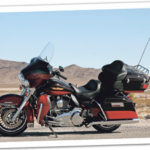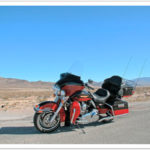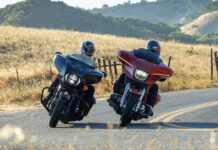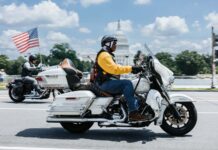Going whole hog
Milwaukee creates their Tourer-de-force
Put succinctly—and semi-literately—what The Motor Company has done in creating the new Electra Glide Ultra Limited is to take the quintessential American long-haul luxury liner and make it quintessentialer. And at the risk of sounding breathless, I’ll go a step further and trumpet that over the course of the five weeks and 2,000 miles I’ve had the behemoth, it has shown itself to be the most complete, commodious and capable all-weather, all-condition touring rig I’ve ridden. And at the risk of sounding like I’m off my meds (i.e., Grolsch), or on the take (don’t I wish), I’ll even add that in comparison to comparably-equipped models of any make on the market, it’s also downright economical both to purchase and to operate.
Milwaukee’s been working up to this epitome of the Touring platform for a long time—starting, you could argue, with the original Electra Glide in 1965 that, when outfitted with the King of the Highway package of windscreen, bags and bits of bling, not only gave the form its timeless profile but also its long-standing King of the Highway nickname. The generations of ever more refined and accoutered successors that ensued retained that crown, though in truth it was a title that at times owed more to the machine’s stylistic tradition and intangible “soul” than to any demonstrable mechanical superiority.
The evolution of the breed over the next 45 years was for the most part incremental—some would say glacial—but it began to pick up some steam in 2007 when the TC 96 and direct-drive Cruise Drive 6-speed transmission were brought to the form, enhancing the powertrain’s roadworthiness mightily. That trajectory got even steeper in 2008 with the addition of Brembo brakes, a 6-gallon fuel tank, rear wheel compensator, and, above all, an electronic throttle that not only smoothed out throttle response but enabled the fitment of an optional antilock braking system.
And then came 2009 and with it a quantum leap in the platform’s development. While the King of the Highway retained its archetypal outward appearance, it was suddenly an entirely new species altogether, sharing only the powertrain and gas tank with the preceding models. As Milwaukee described the complete redesign at the time, “Everything south of the steering head was fair game.” Most notable was a new chassis and swingarm that utterly redefined the platform’s handling characteristics, making the big bikes dramatically more stable and nimble while adding load capacity. It also brought with it new wheels and tires, a retuned suspension, and a re-routed exhaust circuit that by eliminating the rear left-side header pipe, and redirecting the front one, removed a good deal of the heat accumulation that had been a cause of frequent complaints.
With a couple more worthwhile tweaks to the platform for 2010, including especially a much quieter helical-cut fifth cog in the Cruise Drive, the stage was set for the appearance of the Ultra Limited, a model, we’re told, that was cooked up in response to the purchasing pattern of buyers of the Electra Glide Ultra Classic—the company’s biggest-selling model—who were wont to tack a slew of desirable functional options onto the basic stock unit.
Those preferred options that are stock equipment on the Ultra Limited include the ABS, Smart Security System, heated hand grips, liners for the Tour Pak and saddlebags, a luggage rack atop the Tour Pak and a 12-volt power port within.
These are all extremely practical accessories for serious touring, especially when things get wet and cold, and also when you’re moving into and out of motel rooms, but while it’s helpful to use the Ultra Classic and its available optional amenities as a basis for comparing and discussing the new Ultra Limited, it’s also sloppy to take the point too far, characterizing the latter as merely an accessorized version of the former. For one thing, the Limited’s distinctive paint scheme, Chrome Contrast wheels, and titanium-faced gauges with big LED illuminated numerals all combine with the absence of saddlebag rails and the addition of the luggage rack to convincingly distinguish the Ultra Limited as something different. But more importantly, the use of a Twin Cam 103 powerplant in place of the TC 96 gives the model a decidedly different motive personality.
This is the same motor Harley uses on their Trike models to give them the additional oomph to propel their additional mass, and that oomph translates in satisfying ways to the Limited—not that you particularly notice in around-town short-hop duty. It’s when you get the Limited out on the road, and especially out on the Interstate for some heavy-duty touring, that the motor’s 10-percent torque advantage (102 ft/lbs vs. 92.6) over the TC 96 manifests itself.
You notice, for example, that the Cruise Drive transmission’s sixth speed—which only really comes into play on the TC 96 at speeds over 65 mph—is quite content to motor along at speeds down to 55 mph without lugging, and with plenty of quick surge response on tap. That range of happy operation simplifies gear selection at the speeds where you spend a good portion of your touring time, but the real strength of the TC 103 comes under much hairier circumstances.
By that I mean, for example, riding straight into a 30-mph headwind for hours on end. That’s the scenario I endured after leaving Las Vegas BikeFest in October, and I don’t mean winds gusting up to 30 mph, I mean a steady blow gusting up to 45 mph. Even so, the ride was not a matter of buffeted misery in the saddle. Like the Ultra Classic, the Ultra Limited is a mighty bulwark against the gale, armed with its batwing fairings with adjustable wind deflector panels positioned ’neath the wings, and imposing lower fairings with adjustable vents, and the level of wind protection provided is prodigious. Only problem is, when you put that much wind protection into a wind that strong and persistent, it’s a lot like paddling a square canoe upstream into rapids. It takes a lot of muscle.
Here, though, the mighty TC 103 dug deep into its well of torque and powered us along at 75 mph in sixth speed—a feat I would not have thought likely. I only needed to downshift when heading up the desert range inclines.
I should also note that the ambient temperature across the Mojave never rose above the 50s. You can do your own math on the wind chill factor under those circumstances, but suffice it to say I bonded with the Limited’s heated grips. By the end of the day I’d logged 675 miles in about 10 and a half hours—the shortest time it’s ever taken me to cover that distance.
Needless to say, I wasn’t able to determine any heat issues associated with the TC 103 in that well-enclosed cockpit on that ride, and I haven’t ridden in ambient temperatures any warmer than the low 80s since—temperatures at which, in my previous experiences with the TC 96 Ultra Classic, the issue didn’t really arise. (That occurred when the mercury got into the 90s.) What I do know is that the rerouting of the exhaust last year and the affixing of heat baffles at the front of the operator’s seat the year before that combined to reduce heat-associated discomforts considerably on that model. And in the case of the Limited, the TC 103 uses an oil cooler mounted inconspicuously below the voltage regulator which should help in that regard as well.
The sticker price on the Ultra Limited with the basic two-tone paint job is $24,699, which is $2,700 more than the price of a two-tone Ultra Classic. In pricing out the cost of adding all of the Limited’s added features to the Classic, I came to a figure of about $4,300 just for the parts, including the 103-inch upgrade kit. The labor for doing the motor upgrade alone would add about another $1,200, and you can keep adding labor costs from there, but I think you get my point. It was Harley-Davidson’s stated intent in creating the Limited to give customers more of what they wanted in a luxury tourer while bringing to it the economies of factory installation. They’ve certainly succeeded in doing that, and what’s more, they’ve succeeded in making a machine that, from my perspective, extends the riding season and extends the range of conditions you can comfortably ride in. Good deal.























Thank you very much for that excellent review! You covered that bike from front to back. Answered many questions I had but couldn’t find elsewhere. Thanks again.